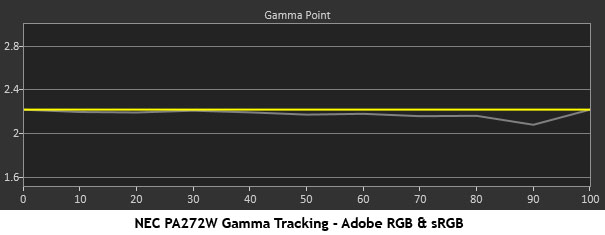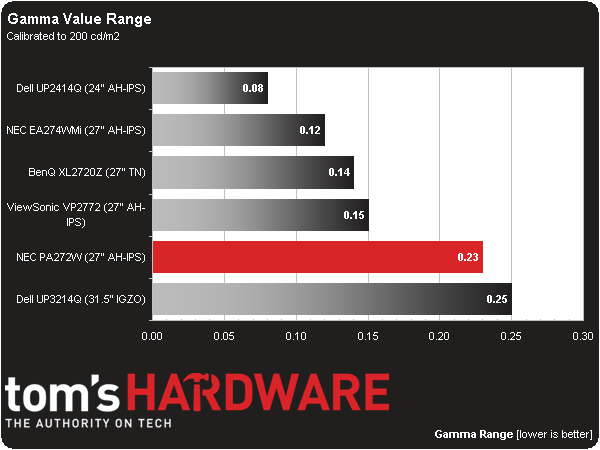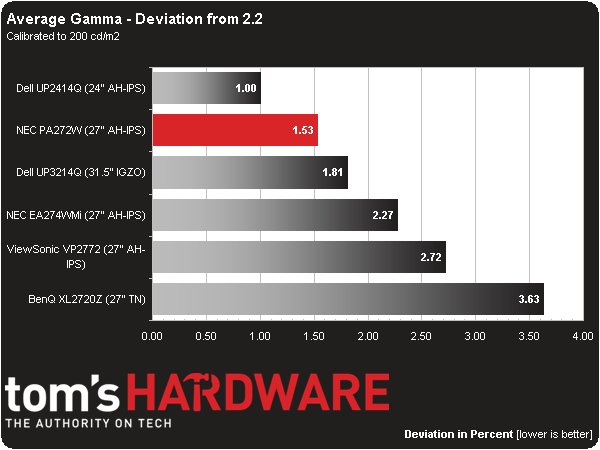NEC PA272W 27-Inch Monitor Review: Accuracy And Flexibility
We’ve reviewed a lot of professional-class monitors, NEC's PA272W may be the most accurate and capable one ever to hit the Tom's Hardware lab. At almost $1300, it’s expensive for a 27-inch QHD screen. But there are features here you won’t find elsewhere.
Results: Grayscale Tracking And Gamma Response
The majority of monitors, especially newer models, display excellent grayscale tracking (even at stock settings). It’s important that the color of white be consistently neutral at all light levels from darkest to brightest. Grayscale performance impacts color accuracy with regard to the secondary colors: cyan, magenta, and yellow. Since computer monitors typically have no color or tint adjustment, accurate grayscale is key.
The most impressive thing about NEC's PA272W is its color accuracy. But you'll put in some work to unlock the monitor’s full potential. We’re going to focus on its three main modes: Adobe RGB, sRGB, and DCI.
NEC includes a factory calibration data sheet with each PA272W. The measured errors are expressed using Delta E 94, which returns slightly lower values compared to the Delta E 2000 standard we use at Tom’s Hardware.
Given the difference between dE94 and dE2000, we pretty much match NEC’s results. This is excellent performance for an uncalibrated screen. The errors barely cross the visible level at 90 and 100 percent. You can see the slightest green tint in those patterns.
Calibration with the RGB sliders produces the following result.
And there's the perfection we expect from a professional monitor like the PA272W. It only takes a couple of small adjustments to lock in amazing tracking in the Adobe RGB or sRGB modes.
The next chart demonstrates why professionals in the film industry should consider this display.
Get Tom's Hardware's best news and in-depth reviews, straight to your inbox.
Digital Cinema Initiative (DCI) is a set of specifications for digital film-making and projection in commercial theaters. It employs a completely different set of parameters for color temperature, gamma, and color gamut, which we’ll show you on the next page. The PA272W is the first computer monitor we've seen that includes a DCI preset. The above result was obtained without any adjustment whatsoever. Talk about impressive.
Here is our comparison group:
We’re showing you the before and after grayscale results for Adobe RGB, sRGB, and DCI. The DCI and sRGB results are excellent for an uncalibrated monitor, while the Adobe RGB result is a tad weak. Granted, it’s still an invisible error. But a monitor like this should measure a little better.
The DCI number is unchanged because we couldn’t improve upon it, even after calibration. The Adobe RGB and sRGB values show nice gains with only small changes to the RGB sliders. Even though the PA272W is very accurate out of the box, calibration helps it achieve near-perfection.
Gamma Response
Gamma is the measurement of luminance levels at every step in the brightness range from 0 to 100 percent. It's important because poor gamma can either crush detail at various points or wash it out, making the entire picture appear flat and dull. Correct gamma produces a more three-dimensional image, with a greater sense of depth and realism. Meanwhile, incorrect gamma can negatively affect image quality, even in monitors with high contrast ratios.
In the gamma charts below, the yellow line represents 2.2, which is the most widely used standard for television, film, and computer graphics production. The closer the white measurement trace comes to 2.2, the better.
The PA272W’s gamma controls are extremely precise. We didn’t have to alter them, even after making changes to the grayscale and color management controls. If you want to use a standard other than 2.2, the presets range from .5 to 4.0 in .1 steps. The dip at 90 percent represents a luminance error of only 2.34 cd/m2.
The DCI v1.2 spec calls for a gamma value of 2.6. In practice, that makes the image look a little darker. But remember, it’s designed for high-powered theater projectors, not LCD monitors. If you’re mastering movie content, though, having this option is a must. Looking at both charts, you can see the gamma tracking is identical at either level.
Here is our comparison group again:
We’re showing you measurements in Adobe RGB, but they're almost identical in the sRGB and DCI modes. While the results aren't as tight as we've seen in the lab, they're well within our standard. If it weren’t for the dip at 90-percent brightness, the result would be perfect.
Gamma deviation is calculated by simply expressing the difference from 2.2 as a percentage.
Again, 90-percent brightness is the only flaw in the PA272W's otherwise perfect gamma performance. The luminance error we measured is completely invisible to the eye both in test patterns and in actual content.
Current page: Results: Grayscale Tracking And Gamma Response
Prev Page Results: Brightness And Contrast Next Page Results: Color Gamut And Performance
Christian Eberle is a Contributing Editor for Tom's Hardware US. He's a veteran reviewer of A/V equipment, specializing in monitors. Christian began his obsession with tech when he built his first PC in 1991, a 286 running DOS 3.0 at a blazing 12MHz. In 2006, he undertook training from the Imaging Science Foundation in video calibration and testing and thus started a passion for precise imaging that persists to this day. He is also a professional musician with a degree from the New England Conservatory as a classical bassoonist which he used to good effect as a performer with the West Point Army Band from 1987 to 2013. He enjoys watching movies and listening to high-end audio in his custom-built home theater and can be seen riding trails near his home on a race-ready ICE VTX recumbent trike. Christian enjoys the endless summer in Florida where he lives with his wife and Chihuahua and plays with orchestras around the state.








